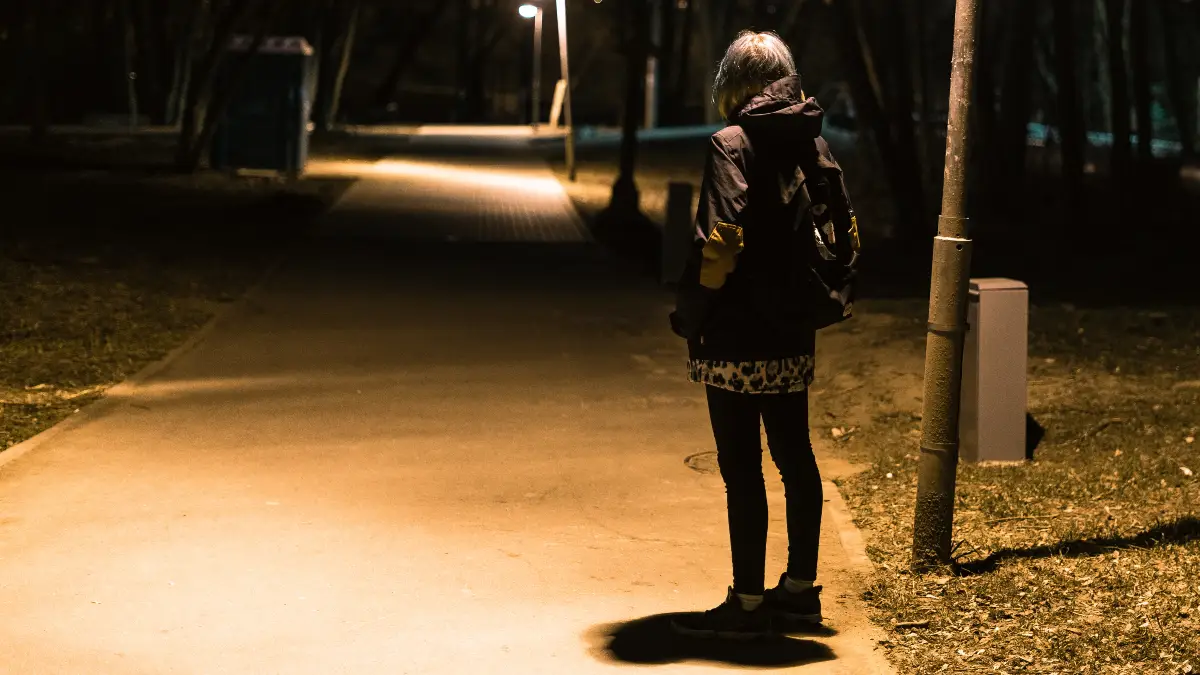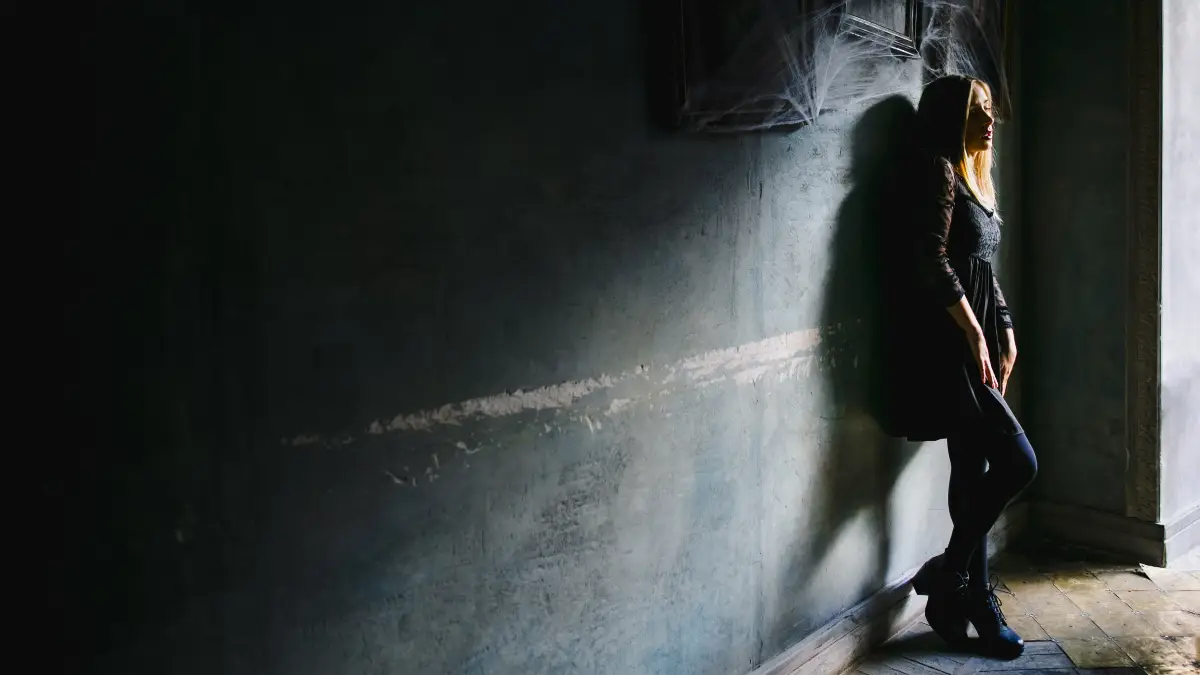Walking alone at night triggers a primal unease in most of us—and that instinct isn’t entirely wrong. While overall violent crime decreased 4.5% in 2024, the darkness still hides potential threats.
But fear doesn’t have to control your life. The difference between being safe and being a target often comes down to one thing: awareness. Research shows that criminals select victims based on observable cues—particularly how you move, what you notice, and how you carry yourself.
The good news? You can master five evidence-based awareness techniques that dramatically reduce your risk without special equipment or training.
1. Maintain relaxed alertness, not paranoia

Ever wondered why some people seem to notice everything around them without looking stressed or scared? They’re living in what security experts call “Condition Yellow”—and it’s your first line of defense when walking alone at night.
Military and law enforcement professionals rely on the Cooper Color Code system, a simple but effective awareness framework with four levels:
- Condition White: Completely unaware, absorbed in your phone or thoughts
- Condition Yellow: Relaxed alertness, casually aware of your surroundings
- Condition Orange: Specific alert, focused on a potential threat
- Condition Red: Action mode, responding to an actual threat
The beauty of Condition Yellow is that it’s sustainable. Unlike constant anxiety or hypervigilance which drain your mental energy and health, you can maintain this relaxed awareness state all day.
You’re simply tuned in to your surroundings without being paranoid. What does this look like in practice? When walking to your car at night, Condition Yellow means you’re scanning the parking lot as you approach.
Noting which cars have people inside, seeing the person walking 20 feet behind you, and having your keys ready—without feeling anxious or fearful.
Research from security training experts shows that situational awareness can reduce casualties even in active threat situations because criminals typically look for easy opportunities. Someone displaying awareness isn’t an easy target.
The biggest mistake? Living in Condition White. That’s when you’re walking with headphones in, staring at your phone, completely absorbed in your thoughts. In this state, you might miss important environmental cues that could keep you safe.
Try these three simple daily practices to develop your Condition Yellow skills:
- The 10-Second Scan: Every 10 seconds, briefly look around you—front, sides, and behind
- The Mental Map: When entering a new area, immediately note exits, potential cover, and other people
- The What-If Game: Occasionally ask yourself “what would I do if…?” to prepare your mind for quick decisions
Maintaining Condition Yellow isn’t about being paranoid—it’s about respecting yourself enough to stay aware. It’s the difference between being prepared and being surprised.
2. Notice what’s normal, then spot what isn’t

What’s “normal” for your neighborhood at 7 PM on Tuesday? How about the subway platform at 11 PM? Understanding what belongs in each environment is the foundation of detecting potential threats before they become problems.
This technique is called baseline and anomaly detection—and it’s used by everyone from FBI agents to military personnel to stay safe.
A baseline is simply the normal pattern for any environment. On your commute, it’s the rhythm of people moving with purpose, dressed for the weather, engaged in typical activities.
Establishing baselines means deliberately noticing these patterns: what people typically wear, how they move, the usual sounds and activity levels.
The real skill is spotting anomalies—deviations from that normal pattern. Pay attention to:
- Attention: Where is someone looking? If everyone’s watching the street performer but one person is scanning the crowd’s bags, that’s significant.
- Clothing: A person in a bulky winter coat on a 90-degree day is an anomaly worth noting.
- Movement: Someone standing still in a flowing crowd or synchronizing with your movements (turning when you turn, stopping when you stop) deserves attention.
- Behavior: People loitering in transitional areas (stairwells, parking lots) with no apparent purpose break the pattern.
This technique works because your brain is already an excellent pattern-recognition machine. Neuroscience research confirms that “the brain can detect and react to some types of danger more rapidly and accurately than a computer through biological motion perception.”
You’re hardwired for this. If everyone’s walking purposefully through a train station except one person who’s standing still watching bags—that’s an anomaly. It might be innocent, but it deserves your attention.
Anomalies don’t automatically mean danger—they’re just information. The street sweeper who doesn’t show up on Tuesday is an anomaly, but not necessarily a threat. You’re gathering data, not jumping to conclusions.
The key is to train yourself to notice these patterns unconsciously, building a continuous environmental awareness that keeps you safer without making you anxious.
3. Walk like someone who refuses to be a victim

“I could tell a victim by the way she walked down the street.”
Those chilling words from serial killer Ted Bundy reveal an uncomfortable truth: predators select targets based primarily on body language.
A landmark study called “Attracting Assault” confirmed this, showing that violent criminals can identify vulnerable victims just by watching them walk.
The good news? You can immediately change how potential threats perceive you by adjusting three elements of your body language:
- Confidence: Shoulders back, head up, open posture
- Purpose: Deliberate stride, natural arm swing, forward momentum
- Coordination: Balanced weight shift, synchronized movement
Research shows that 70-90% of communication is non-verbal, which means your body is constantly broadcasting messages about whether you’re a hard or easy target. A 2013 study found that 47 violent crime inmates primarily used gait to assess vulnerability.
Predators are looking for these signals of vulnerability:
- Hunched posture
- Head down, avoiding eye contact
- Short, shuffling steps
- Arms crossed or in pockets
- Looking at phone
Instead, practice projecting confidence:
- Head up, scanning environment
- Shoulders back, chest open
- Purposeful stride with natural arm swing
- Brief eye contact with passersby
Eye contact deserves special mention. Brief, confident eye contact for a split second signals “I see you, I’m aware of you” without being confrontational. This simple act removes the element of surprise that predators count on.
“Criminals can make a target selection decision in less than seven seconds,” explains self-defense expert Gemma Sheehan. “By presenting yourself as a hard target, the predator will move on and look elsewhere.”
You don’t have to feel confident to appear confident. Research on “power posing” shows that adopting confident body language actually changes your hormone levels (raising testosterone, lowering stress hormones) and makes you feel more powerful. Fake it until you make it works.
Practice this in low-stress situations. Walk confidently through the grocery store. Stand tall in line at the coffee shop. By the time you need this skill walking alone at night, it will be second nature.
4. Your phone is the enemy of your awareness

Look around any public space and you’ll see people walking with their heads down, absorbed in their phones, wearing noise-canceling headphones. From a safety perspective, they might as well be wearing blindfolds.
Your digital devices create a dangerous hierarchy of distractions:
- Phone use tops the list—scrolling, texting, and social media create a tunnel vision effect that eliminates peripheral awareness
- Headphones/earbuds block crucial auditory warnings and signals
- Deep conversations (in person or on calls) consume mental bandwidth needed for environmental scanning
- Fatigue and substances create an unavoidable state of diminished awareness
This isn’t just common sense—it’s backed by official guidelines. Department of Homeland Security 2024 safety protocols explicitly state: “Do not use cell phone while walking in public areas. Avoid walking with headphones or earpluds.”
The science behind this is called “inattentional blindness.” When your attention is focused internally or on a specific task, you literally cannot perceive potential threats in your environment—even if they’re right in front of you.
A woman texting while walking from her car to her building entrance, headphones in, completely absorbed. She’s displaying the textbook victim profile that predators actively seek.
If you absolutely must take a call while walking at night, keep it brief, stay in well-lit areas, and maintain visual awareness even while talking. Better yet, wait until you reach a safe location to make calls or check messages.
Walking home from a late shift? Keep your phone in your pocket (not in your hand scrolling), no headphones, clear mind without preoccupations, well-rested. This equals maximum awareness capability.
Your phone should be out only if you’re actively sharing your location with someone or if you’re feeling unsafe and calling for help. In these cases, the safety benefit outweighs the distraction cost.
The most sophisticated personal safety app in the world can’t help you if you don’t see the threat coming.
5. That uneasy feeling? It’s your brain protecting you

Have you ever felt suddenly uneasy for no apparent reason? That uncomfortable feeling isn’t paranoia or anxiety—it’s your brain’s sophisticated threat detection system at work.
Security expert Gavin de Becker calls this “the gift of fear” in his groundbreaking book of the same name. “Like every creature on earth, we have an extraordinary defense resource. We don’t have the sharpest claws—but we do have the biggest brains, and intuition is the most impressive process of these brains.”
Your intuition works by subconsciously processing subtle cues your conscious mind hasn’t registered yet. That strange feeling is your brain recognizing a potential threat pattern before you can consciously identify it.
De Becker identifies seven pre-incident indicators (PINS) that often trigger these gut feelings:
- Forced teaming: Creating a false sense of “we’re in this together” (“Let’s figure this out”)
- Charm offensive: Using excessive charm to disarm you
- Too many details: Providing unnecessary information to seem credible
- Typecasting: Mild insult to make you prove something (“You’re probably too scared to…”)
- Loan sharking: Offering unsolicited help to create obligation
- Unsolicited promises: “I promise I won’t hurt you” (why would they need to say this?)
- Refusing to hear “no”: Persistence despite clear refusal
Real fear is sudden, situational, brief, and action-oriented. Anxiety is persistent, general, and often immobilizing. When you feel that sudden intuitive discomfort, it’s almost always the former.
How should you act on these feelings? Immediately. If you’re walking past an alley and feel sudden unease despite seeing nothing obvious—cross to the other side immediately. Don’t investigate.
Someone offers unsolicited help with your groceries and won’t take no for an answer? That’s the “Loan Sharking” and “Discounting No” PINS at work.
De Becker identifies denial as “the enemy of safety.” We often ignore intuition in favor of logic, particularly when social pressure dictates politeness. But the most dangerous words in personal safety are: “I don’t want to be rude.”
Your subconscious processes thousands of environmental cues per second. That “gut feeling” is your brain detecting a pattern that matches threat indicators—even if you can’t consciously articulate what’s wrong. It’s been keeping humans alive for millennia.
Trust yourself. Honor that discomfort. Act on it without apology. It’s not paranoia—it’s your most powerful protective tool.


